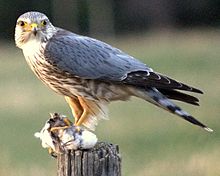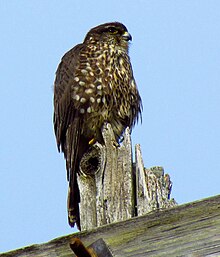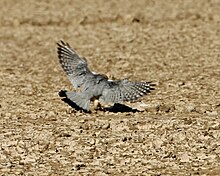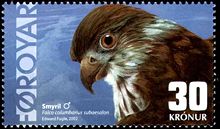Merlin (bird)
| Merlin | |
|---|---|

| |
| Male prairie merlin (F. c. richardsoni) with prey in Alberta (Canada) | |
| Scientific classification | |
| Domain: | Eukaryota |
| Kingdom: | Animalia |
| Phylum: | Chordata |
| Class: | Aves |
| Order: | Falconiformes |
| Family: | Falconidae |
| Genus: | Falco |
| Species: | F. columbarius
|
| Binomial name | |
| Falco columbarius | |
| Subspecies | |
|
3–9 subspecies (see text) | |

| |
| Range of F. columbarius Summer only range Year-round range Winter only range
| |
| Synonyms | |
|
Aesalon columbarius (Linnaeus, 1758) | |
The merlin (Falco columbarius) is a small
Nomenclature
The merlin was described and illustrated by the English naturalist
The name "merlin" is derived from
Although the merlin shares its name with the wizard
Systematics
The relationships of the merlin are not resolved to satisfaction. In size, shape and coloration, it is fairly distinct among living falcons. The

In that regard, a
Subspecies
That the merlin has a long-standing presence on both sides of the Atlantic is evidenced by the degree of genetic distinctness between Eurasian and North American populations. Arguably, they might be considered distinct species, with gene flow having ceased at least a million years ago, but probably more.[9]
By and large, color variation in either group independently follows
American group[8]
- Falco columbarius columbarius (Linnaeus, 1758) – taiga merlin, boreal merlin, tundra merlin
- Falco columbarius richardsonii (Ridgway, 1871) – prairie merlin
- Falco columbarius suckleyi (Ridgway, 1873) – black merlin, coastal forest merlin
- Pacific coast of North America, from S Alaska to N Washingtonstate. Resident (some altitudinal movements).
Eurasian group[8]
- Falco columbarius/aesalon aesalon (Tunstall, 1771) – Eurasian merlin
- Northern Eurasia from Mediterranean region to about Iran.

- Falco columbarius/aesalon subaesalon Icelandic)
- Iceland and Faroe Islands. Latter population has some gene flow with aesalon. Resident (some winter dispersal).
- Falco columbarius/aesalon pallidus (Sushkin, 1900) – pallid merlin, steppe merlin
- Asian Altay Mountains. Migratory, winters in S Central Asia and N South Asia.
- Falco columbarius/aesalon insignis (Clark, 1907) – East Siberian merlin
- Siberia between Kolyma Rivers. Migratory, winters in continental East Asia.
- Falco columbarius/aesalon lymani (Bangs, 1913) – Central Asian merlin
- Mountains of eastern Kazakhstan and surrounding countries. Short-distance migrant.
- Falco columbarius/aesalon pacificus (Stegmann, 1929) – Pacific merlin
- Russian Far East to Sakhalin. Migratory, winters in Japan, Korea and nearby.
Description

The merlin is 24–33 cm (9.4–13.0 in) long with a 50–73 cm (20–29 in) wingspan.
The male merlin has a blue-grey back, ranging from almost black to

The
Light American males may resemble the American kestrel (F. sparverius, not a typical kestrel), but merlin males have a grey back and tail rather than the reddish-brown of the kestrels. Light European males can be distinguished from kestrels by their mainly brown wings. In the north of South Asia, wintering males may be confused with the red-necked falcon (F. chicquera) if they fly away from the observer and the head (red on top in F. chicquera) and underside (finely barred with black in F. chicquera) are not visible.[21]
Ecology
Merlins inhabit fairly open country, such as
Most of its populations are migratory, wintering in warmer regions. Northern European birds move to southern
Merlins rely on speed and agility to hunt their prey. They often hunt by flying fast and low, typically less than 1 m (3.3 ft) above the ground, using trees and large shrubs to take prey by surprise. But they actually capture most prey in the air, and will "tail-chase" startled birds. Throughout its native range, the merlin is one of the most able aerial predators of small to mid-sized birds, more versatile if anything than the larger hobbies (which prefer to attack in mid-air) and the more nimble sparrowhawks (which usually go for birds resting or sleeping in dense growth). Breeding pairs will frequently hunt cooperatively, with one bird flushing the prey toward its mate.[8][22]
The merlin will readily take prey that is flushed by other causes, and can for example be seen tagging along
In particular during the breeding season, most of the prey are smallish birds weighing 10–40 g (0.35–1.41 oz). Almost any such
Larger birds (e.g.
Reproduction


Breeding occurs typically in May/June. Though the pairs are
Three to six (usually 4 or 5) eggs are laid. The rusty brown eggs average at about 40 mm × 31.5 mm (1.57 in × 1.24 in).[
Relationship with humans

William Lewin illustrates the merlin as Plate 22 in volume 1 of his Birds of Great Britain and their Eggs, published 1789 in London.
Use in falconry
In medieval Europe, merlins were popular in
Quoting expert falconer Matthew Mullenix, author of the book "American Kestrels in Modern Falconry", in an article comparing the American kestrel to the merlin he states "What a merlin gives you is raw power: lots of it. It brings an ability to negate wind as a factor, to stay airborne at a tremendous clip then gear down further at any time for more performance. One merlin can dominate an entire flock of frightened birds, directing its fate as a whole. The flock responds like bait fish to a barracuda and for precisely the same reason. Merlins demonstrate total mastery of their element."[42] Concerning suitable game for these two species, he states "To snipe, dove, quail and open-country sparrows, merlins are best suited. For most blackbirds (Icteridea), either falcon can prove effective. Starlings in close are extremely vulnerable to kestrels; but in the open are best prey for merlins."
Status and conservation
Altogether, the merlin is not particularly rare, and due to this and its wide range it is considered a species of
By far the most serious long-term threat to these birds is habitat destruction, especially in their breeding areas. Ground-nesting populations in moorland have a preference for tall heather, and are thus susceptible to overmanagement by burning vast tracts instead of creating a habitat mosaic containing old and new growth. Still, the merlin is rather euryoecious (adaptable to various conditions) and will even live in settled areas, provided they have the proper mix of low and high vegetation, as well as sufficient prey (which is usually the case) and nesting sites (which is a common limiting factor).[8]
In North America, the species seems to have been more widespread in the past, or perhaps its range has shifted northwards: F. c. columbarius was an uncommon breeding bird in
Perhaps the most frequent cause of accidental death for individuals is collision with man-made objects, particularly during attacks. This may account for almost half of all premature deaths of merlins. In the 1960s and 1970s,
See also
- Perlin, a hybrid of a merlin and a peregrine falcon.
References
- ^ . Retrieved 12 November 2021.
- ^ "Merlin Overview, All About Birds, Cornell Lab of Ornithology". www.allaboutbirds.org. Retrieved 2020-01-29.
- ^ Catesby, Mark (1729–1732). The natural history of Carolina, Florida and the Bahama Islands (in English and French). Vol. 1. London: W. Innys and R. Manby. p. 3, plate 3.
- ^ "Merlin". Audubon. 2014-11-13. Retrieved 2020-01-27.
- ^ Linnaeus, Carl (1758). Systema Naturæ per regna tria naturae, secundum classes, ordines, genera, species, cum characteribus, differentiis, synonymis, locis (in Latin). Vol. 1 (10th ed.). Holmiae (Stockholm): Laurentii Salvii. p. 90.
- ISBN 978-0199206872.
- ISBN 978-1-4081-2501-4.
- ^ ISBN 84-87334-15-6.
- ^ a b c d Wink, Michael; Seibold, I.; Lotfikhah, F.; Bednarek, W. (1998). Chancellor, R.D.; Meyburg, B.-U.; Ferrero, J.J. (eds.). Molecular systematics of holarctic raptors (Order Falconiformes) (PDF). Holarctic Birds of Prey. Adenex & WWGBP. pp. 29–48.
- ^ a b "merlin". Oxford English Dictionary (Online ed.). Oxford University Press. (Subscription or participating institution membership required.)
- ^ Wilson Bulletin. 18 (2): 47–60.
- ^ "Bird of The Week: Merlin". Kern Audubon Society. February 28, 2021. Retrieved 2022-10-14.
- ^ a b Helbig, A.J.; Seibold, I.; Bednarek, W.; Brüning, H.; Gaucher, P.; Ristow, D.; Scharlau, W.; Schmidl, D.; Wink, Michael (1994). Meyburg, B.-U.; Chancellor, R.D. (eds.). Phylogenetic relationships among falcon species (genus Falco) according to DNA sequence variation of the cytochrome b gene (PDF). Raptor conservation today. pp. 593–599.
- JSTOR 4089459.
- PMID 12414309.
- ^ Martin, R.A.; Honey, J.G.; Pelaez-Campomanes, P. (2000). "The Meade Basin Rodent Project; a progress report. Kansas Geological Survey Open-file Report 2000-61". Paludicola. 3 (1): 1–32.
- JSTOR 4083714.
- ^ a b c "Annotated Ohio state checklist" (PDF). Ohio Ornithological Society (OOS). 2004. Archived from the original (PDF) on 18 July 2004. Retrieved 29 October 2009.
- ^ ISBN 0-618-12762-3.
- ^ Davis, Kate (2002). Falcons of North America. Mountain Press Publishing Company.
- ^ ISBN 84-87334-15-6.
- ISBN 84-87334-20-2.
- ^ a b Olson, Storrs L.; James, Helen F.; Meister, Charles A. (1981). "Winter field notes and specimen weights of Cayman Island Birds" (PDF). Bulletin of the British Ornithologists' Club. 101 (3): 339–346.
- ^ a b c d "Falco columbarius (Merlin)". Animal Diversity Web.
- ^ Ferguson-Lees, J. & Christie, D.A. & Franklin, K. & Mead, D. & Burton, P.. (2001). Raptors of the world. Helm Identification Guides.
- ^ "Merlin". Carolina Raptor Center. Archived from the original on 27 July 2010.
- ^ Ferguson-Lees, J. & Christie, D.A. & Franklin, K. & Mead, D. & Burton, P.. (2001). Raptors of the world. Helm Identification Guides.
- ^ Ferguson-Lees, J. & Christie, D.A. & Franklin, K. & Mead, D. & Burton, P.. (2001). Raptors of the world. Helm Identification Guides.
- JSTOR 4162530.
- ^ UWI St. Augustine. Retrieved 2023-12-16.
- ^ Ferguson-Lees, J. & Christie, D.A. & Franklin, K. & Mead, D. & Burton, P.. (2001). Raptors of the world. Helm Identification Guides.
- .
- ^ Ferguson-Lees, J. & Christie, D.A. & Franklin, K. & Mead, D. & Burton, P.. (2001). Raptors of the world. Helm Identification Guides.
- ^ Ferguson-Lees, J. & Christie, D.A. & Franklin, K. & Mead, D. & Burton, P.. (2001). Raptors of the world. Helm Identification Guides.
- ^ "Merlin". The Peregrine Fund. Retrieved 2023-12-16.
- ^ Ferguson-Lees, J. & Christie, D.A. & Franklin, K. & Mead, D. & Burton, P.. (2001). Raptors of the world. Helm Identification Guides.
- ^ Dunn, Pete (2012). Hawks in Flight (Second ed.). Houghton Mifflin Harcourt.
- ^ "Falco columbarius life history data". AnAge]. 2009.
- ^ "Audubon's Watercolors: The Complete Avian Collection: The New-York Historical Society Edition". Archived from the original on 14 July 2014. Retrieved 19 June 2014.
- ^ ISBN 0-88839-978-2.
- ^ "Merlin | Hawk Mountain Sanctuary: Learn Visit Join". www.hawkmountain.org. Retrieved May 18, 2016.
- ^ "Merlin Falconry by Eric Edwards". www.merlinfalconry.com. Retrieved May 20, 2016.
External links
- Merlin Species Account – Cornell Lab of Ornithology
- Merlin - Falco columbarius - USGS Patuxent Bird Identification InfoCenter
- Picture of Black Merlin (Falco columbarius suckleyi subspecies)
- Merlin photos at Oiseaux.net
- Ageing and sexing (PDF; 5.3) by Javier Blasco-Zumeta & Gerd-Michael Heinze
- Audio recordings of Merlins on Xeno-canto.
- Merlin, Canadian Peregrine Foundation
- "Merlin media". Internet Bird Collection.
- Merlin photo gallery at VIREO (Drexel University)
- [1] Merlin Falcon Foundation
Historical material
- "The Merlin, called in Latine Æsalon." Page 85 in The Ornithology of Francis Willughby, translated by John Ray (1678). Engraving of a perched merlin, tableaux III.
- "Falco columbarius, Pigeon Hawk"; from American Ornithology 2nd edition, volume 1 (1828) by Alexander Wilson and George Ord. Colour plate from 1st edition by A. Wilson.
- "The Pigeon Hawk" and "Le Petit Caporal", John James Audubon, Ornithological Biography volume 1 (1831). At Pigeon Hawk; Petit Caporal, in the appendix to Ornithological Biography volume 5 (1839), Audubon notes that his Falco temerarius of volume 1 was a small male merlin, and that this was brought to his attention by Charles Bonaparte, nephew of "the little corporal". Illustration from Birds of America octavo edition, 1840.

